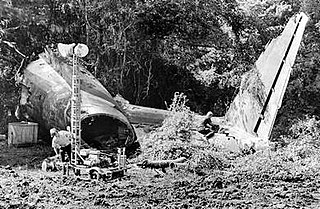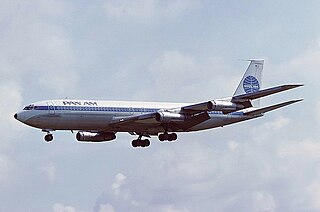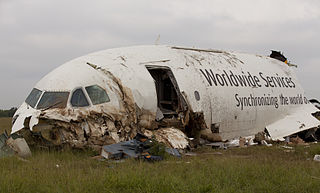Related Research Articles

United Airlines Flight 232 was a regularly scheduled United Airlines flight from Stapleton International Airport in Denver to O'Hare International Airport in Chicago, continuing to Philadelphia International Airport. On July 19, 1989, the DC-10 serving the flight crash-landed at Sioux City, Iowa, after suffering a catastrophic failure of its tail-mounted engine due to an unnoticed manufacturing defect in the engine's fan disk, which led to the loss of many flight controls. Of the 296 passengers and crew on board, 112 died during the accident, while 184 people survived. It is also the deadliest single-aircraft accident in the history of United Airlines.

Aviation safety is the study and practice of managing risks in aviation. This includes preventing aviation accidents and incidents through research, educating air travel personnel, passengers and the general public, as well as the design of aircraft and aviation infrastructure. The aviation industry is subject to significant regulation and oversight.

On the evening of February 1, 1991, USAir Flight 1493, a Boeing 737-300, collided with SkyWest Airlines Flight 5569, a Fairchild Swearingen Metroliner turboprop aircraft, upon landing at Los Angeles International Airport (LAX). Though air traffic was not heavy at LAX, as Flight 1493 was on final approach, the local controller was distracted by a series of abnormalities, including a misplaced flight progress strip and an aircraft that had inadvertently switched off the tower frequency. The SkyWest flight was told to taxi into takeoff position, while the USAir flight was landing on the same runway.

Blue Grass Airport is a public airport in Fayette County, Kentucky, United States, 6 miles west of downtown Lexington. Located among horse farms and situated directly across from Keeneland Race Course, Blue Grass Airport is the primary airport serving central and eastern Kentucky. More than 1.3 million passengers depart or arrive annually at Blue Grass Airport. In 2017, the airport served 1,316,847 passengers via four major airline carriers: Allegiant Air, American Airlines, Delta Air Lines, and United Airlines.

USAir Flight 405 was a regularly scheduled domestic passenger flight between LaGuardia Airport in Queens, New York City, New York, and Cleveland, Ohio. On March 22, 1992, a USAir Fokker F28, registration N485US, flying the route, crashed in poor weather in a partially inverted position in Flushing Bay, shortly after liftoff from LaGuardia. The undercarriage lifted off from the runway, but the airplane failed to gain lift, flying only several meters above the ground. The aircraft then veered off the runway and hit several obstructions before coming to rest in Flushing Bay, just beyond the end of the runway. Of the 51 people on board, 27 were killed, including the captain and a member of the cabin crew.

Eastern Air Lines Flight 212 was a controlled flight into terrain accident of a McDonnell Douglas DC-9 during approach to Charlotte Douglas International Airport in North Carolina. The incident occurred on September 11, 1974, killing 72 of the 82 people on board. The scheduled flight was from Charleston Municipal Airport to Chicago O'Hare, with an intermediate stop in Charlotte.

The 2005 Logan Airport runway incursion was a near-collision that occurred at approximately 7:40 p.m. EDT on June 9, 2005 between US Airways Flight 1170 (US1170) and Aer Lingus Flight 132 (EI132). EI132 was an Airbus A330-300 aircraft, owned and operated by the Irish airline Aer Lingus, destined for Shannon, Ireland and carrying 12 crew members and 260 passengers. US1170 was a Boeing 737-300 US Airways flight destined for Philadelphia and carrying six crew members and 103 passengers. The near-collision took place on the runway at Logan International Airport (BOS) in Boston, Massachusetts.

Comair Flight 5191 was a scheduled United States domestic passenger flight from Lexington, Kentucky, to Atlanta, Georgia. On the morning of August 27, 2006, at around 06:07 EDT, the Bombardier Canadair Regional Jet 100ER crashed while attempting to take off from Blue Grass Airport in Fayette County, Kentucky, 4 miles (6.4 km) west of the central business district of the city of Lexington.

Trans World Airlines (TWA) Flight 159 was a regularly scheduled passenger flight from New York City to Los Angeles, California, with a stopover in Cincinnati/Northern Kentucky International Airport, Kentucky, that crashed after an aborted takeoff from Cincinnati on 6 November 1967. The Boeing 707 attempted to abort takeoff when the copilot became concerned that the aircraft had collided with a disabled DC-9 on the runway. The aircraft overran the runway, struck an embankment and caught fire. One passenger died as a result of the accident.

TWA Flight 843 was a scheduled Trans World Airlines passenger flight that crashed after an aborted takeoff from John F. Kennedy International Airport to San Francisco International Airport (California) in July 1992. Despite an intense fire after the crash, the crew was able to evacuate all 280 passengers from the aircraft. There was no loss of life, though the aircraft was destroyed by the fire.

A runway incursion is an aviation incident involving improper positioning of vehicles or people on any airport runway or its protected area. When an incursion involves an active runway being used by arriving or departing aircraft, the potential for a collision hazard or Instrument Landing System (ILS) interference can exist. At present, various runway safety technologies and processes are commonly employed to reduce the risk and potential consequences of such an event.

The 2007 San Francisco International Airport runway incursion occurred around 1:36 p.m. PDT on May 26, 2007 when SkyWest Airlines Flight 5741, an Embraer EMB 120 Brasilia turboprop aircraft, nearly collided with Republic Airways Flight 4912, an Embraer 170 Regional Jet, at the intersection of Runways 1L and 28R at San Francisco International Airport (SFO).

Pan Am Flight 816 was an international flight from Auckland, New Zealand, to San Francisco, California, via Tahiti, French Polynesia and Los Angeles. It was operated by a Pan Am Boeing 707-321B bearing the registration N417PA and named Clipper Winged Racer. On July 22, 1973, at 10:06 P.M. local time, the Boeing 707 took off from Faa'a International Airport in Papeete. Thirty seconds after takeoff, the airliner, carrying 79 passengers and crew, crashed into the sea.

Continental Airlines Flight 1404 was a Continental Airlines flight from Denver International Airport in Denver, Colorado, to George Bush Intercontinental Airport in Houston, Texas. On the evening of December 20, 2008, the flight crashed while taking off from Denver, resulting in two critical injuries, 36 noncritical injuries, and a hull loss of the Boeing 737-524 aircraft.
Runway safety is concerned with reducing harm that could occur on an aircraft runway. Safety means avoiding incorrect presence (incursion) of aircraft, inappropriate exits (excursion) and use of the wrong runway due to confusion. The runway condition is a runway's current status due to meteorological conditions and air safety.

UPS Airlines Flight 1354 was a scheduled cargo flight from Louisville, Kentucky, to Birmingham, Alabama. On August 14, 2013, the Airbus A300 flying the route crashed and burst into flames short of the runway on approach to Birmingham–Shuttlesworth International Airport. Both pilots were pronounced dead at the scene of the crash. They were the only people aboard the aircraft. It was the second fatal air crash for UPS Airlines.

The International Civil Aviation Organization (ICAO) defines fatigue as "A physiological state of reduced mental or physical performance capability resulting from sleep loss or extended wakefulness, circadian phase, or workload." The phenomenon places great risk on the crew and passengers of an airplane because it significantly increases the chance of pilot error. Fatigue is particularly prevalent among pilots because of "unpredictable work hours, long duty periods, circadian disruption, and insufficient sleep". These factors can occur together to produce a combination of sleep deprivation, circadian rhythm effects, and 'time-on task' fatigue. Regulators attempt to mitigate fatigue by limiting the number of hours pilots are allowed to fly over varying periods of time.

Air Transport International Flight 782 was a ferry flight from Kansas City International Airport in Missouri to Westover Metropolitan Airport in Springfield, Massachusetts using a Douglas DC-8-63 with one of its 4 engines inoperative. On February 16, 1995, the aircraft failed to takeoff from Kansas City, went off the runway, and crashed. All three flight crew members, the only occupants on board, were killed. The cause was deemed to be improper training, which resulted in the crew failing to understand a three-engine takeoff procedure. In addition, the FAA's oversight of rest regulations and the airline were both poor.

Tower Air Flight 41 was a scheduled domestic passenger flight from John F. Kennedy International Airport (JFK) in New York City, to Miami International Airport (MIA) in Florida. On December 20, 1995, the Boeing 747-100 operating the flight veered off the runway during takeoff from JFK. All 468 people on board survived, but 25 people were injured. The aircraft was damaged beyond repair and written off, making the accident the 25th hull loss of a Boeing 747. The National Transportation Safety Board (NTSB) concluded that the captain had failed to reject the takeoff in a timely manner.
In-flight crew relief, is a term used in commercial aviation when referring to the members of an aircrew intended to temporarily relieve active crew members of their duties during the course of a flight. The term and its role are almost exclusively applied to the secondary pilots of an aircrew, commonly referred to as relief pilots, that relieve the primary and active captain and/or first officer (co-pilot) in command of an aircraft to provide prolonged breaks for rest or sleep opportunities.
References
- ↑ Fatigue Factors in Regional Airline Operations Archived 2008-04-29 at the Wayback Machine , NTSB
- ↑ Tired pilots forced to sleep on plane Archived 2008-08-29 at the Wayback Machine , WFAA Channel 8
- ↑ NASA ASRA Report, 37,000 feet
- ↑ NASA ASRA Report Archived 2011-07-21 at the Wayback Machine , FAA
- ↑ NASA ASRA Report Archived 2011-07-21 at the Wayback Machine , FAA
- ↑ NASA ASRA Report Archived 2011-07-21 at the Wayback Machine , FAA
- ↑ NASA ASRA Report Archived 2011-07-21 at the Wayback Machine , FAA
- ↑ NASA ASRA Report Archived 2011-07-21 at the Wayback Machine , FAA
- ↑ NASA ASRA Report Archived 2011-07-21 at the Wayback Machine , FAA
- ↑ NASA ASRA Report Archived 2011-07-21 at the Wayback Machine , FAA
- ↑ NASA ASRA Report Archived 2011-07-21 at the Wayback Machine , FAA
- ↑ NASA ASRA Report Archived 2011-08-16 at the Wayback Machine , FAA
- ↑ NASA ASRA Report Archived 2011-08-16 at the Wayback Machine , FAA
- ↑ NASA ASRA Report Archived 2011-08-16 at the Wayback Machine , FAA
- ↑ NASA ASRA Report Archived 2011-08-16 at the Wayback Machine , FAA